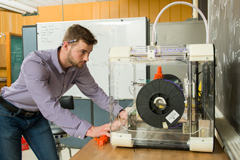August 18, 2014
New generation technologies prepare students for modern-day engineering
Submitted by Michele Bradfield

Minutes before their next mission, three armed soldiers realize a part from their tank has gone awry. Without missing a beat they identify the problem, print the part, assemble the piece and head into battle.
These are the type of scenarios modern-day engineers predict in preparation for tomorrow, as new generation technologies such as 3-D printers advance and bode an industrial revolution. The implication has leaders in defense, aerospace, automotive, health care and schools rethinking their strategies and operations as they prepare to join the trend.
Shuting Lei, professor of industrial and manufacturing systems engineering at Kansas State University, ponders the same questions. Specifically, as 3-D printers evolve, what impact will they have on current students and recent graduates? Such technology will inevitably change the way engineers manufacture and distribute products. Lei says that the ability to print in real time shortens the development cycle and could potentially reduce or eliminate the need for traditional manufacturing techniques that currently require manpower, tools, assembly lines and supply chains.
"Industry is on the verge of significant change and it's imperative that our students are introduced to new manufacturing technologies as we prepare them to enter the workforce," said Lei. "As educators, this is our highest priority."
In February 2014, Lei unveiled the industrial and manufacturing systems engineering department's first 3-D printer. He introduced the new technology to his manufacturing students and challenged them with a project that turned textbook methods into hands-on experience. The project required a three phase approach: design, print and test.
"Students learned the advantages associated with 3-D printing like direct bottom-up manufacturing and ease of making complex shapes," said Lei. "They also realized the imperfections of current 3-D printing technologies like the limitations on materials and speed."
Until recently, 3-D printers have been cost prohibitive to consumers, even though they have existed for decades. Finally at an affordable price point, the industrial and manufacturing systems engineering department purchased the 3-D printer for use in classroom projects and graduate research. Motivated and fully engaged, Lei's students pioneered the first project. The new technology enabled them to conceptualize an idea and watch it materialize.
"The printer connected to a laptop takes a 3-D computer model and slices it into layers," said Ryan Manes, undergraduate research assistant for Lei. "A robot moves the heated extruder head along each layer and lays down the molten thermoplastic one layer at a time until a threedimensional part appears."
With one successful project under his belt, Lei's long-term goal is to integrate 3-D printing into more industrial and manufacturing systems engineering courses. Ideally, he would like every student in the department to have an opportunity to learn the technology and operate the software firsthand. By exposing students to the early stage developments of this game-changing technology, Lei intends to prepare them for the manufacturing evolution that is guaranteed to change world industry as we know it today.
